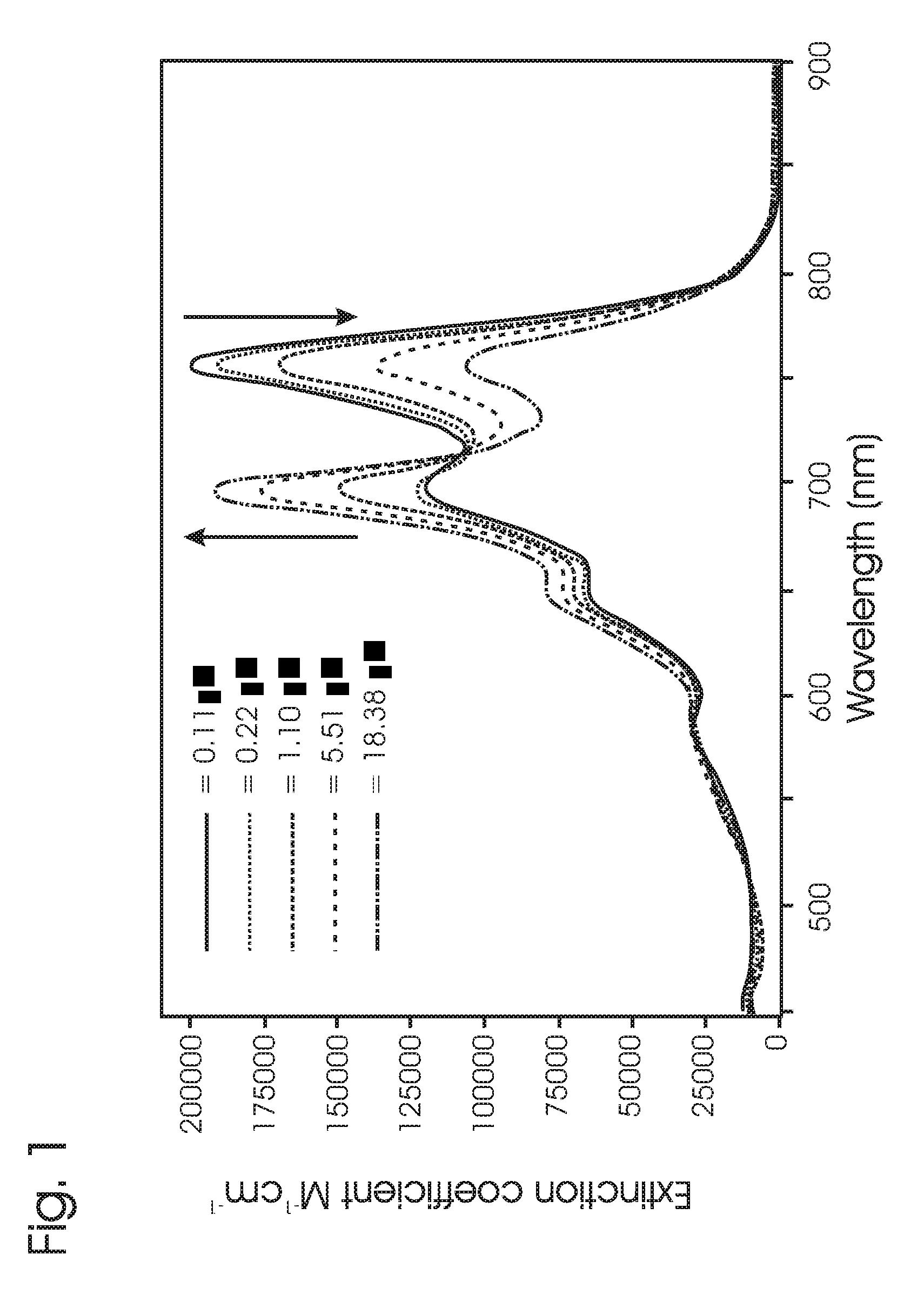Luminescent compounds
a technology of luminescent compounds and compounds, applied in the field of luminescent compounds, can solve the problems of very selective luminescence methods and sensitive luminescence methods
- Summary
- Abstract
- Description
- Claims
- Application Information
AI Technical Summary
Problems solved by technology
Method used
Image
Examples
example 1
Synthesis of Precursors
[0103] This section describes the synthesis of various precursors. p-hydrazinobenzene sulfonic acid (Illy et al., J. Org. Chem. 33, 4283-4285, 1968), 1-(5-carboxypentyl)-2,3,3-trimethyl-3H-5-indoliumsulfonate (1a), 2,3,3-trimethylindole-5-sulfonic acid potassium salt (1b), 1-(3-sulfonato propyl)-2,3,3-trimethylindoleninium-5-sulfonate (1h) (Mujumdar et al., Bioconj. Chem. 4(2) 105-111, 1993), and 1,2,3,3-tetramethylindoleninium-5-sulfonate (1c) were synthesized using literature procedures. 1d-1f are synthesized according to the procedures provided in U.S. Patent Application Publication No. 2002 / 0077487. 1-(2-phosphonethyl)-2,3,3-trimethylindoleninium-5-sulfonate (1i) is described in PCT Patent Application Publication No. WO 01 / 36973.
[0104] Other starting materials such p-hydranzino-phenylacetic acid and the relevant indolenine are described in Southwick et al., Cytometry 11, 418-430 (1990). Finally, starting materials for cationic dyes containing quaternary ...
example 2
Synthesis of symmetrical bis-squarylium dyes (5)
Triethylammonium 3-dicyanomethylene-4-oxo-2-(1,3,3-trimethyl-2,3-dihydro-1H-2-indolylidenmethyl)-1-cyclobuten-1-olate (4)
[0152]
[0153] 1 ml (7.14 mmol) of TEA was added dropwise to a mixture of 2 g (6.15 mmol) of mono-substituted squaraine 4a (A. Tartarets et al., Dyes & Pigments, 64, 125-134, 2005), 440 mg (6.66 mmol) of malononitrile in 35 ml of ethanol and stirred for 2 h at room temperature. The solvent was removed under reduced pressure. The raw product was column purified (Silica gel 60, 0-2% methanol-chloroform) to give (2.52 g, 98%) 4b as orange crystals, mp 153° C.; Analysis: N, 13.44 C25H30N4O2 requires N, 13.39%; δH (200 MHz, DMSO-d6) 8.74 (1H, br s, NH+), 7.29 (1H, d, 7.5 Hz, arom H), 7.20 (1H, t, 7.5 Hz, arom H), 6.95 (1H, d, 8.3 Hz, arom H), 6.93 (1H, t, 7.8 Hz, arom H), 5.92 (1H, s, CH), 3.25 (3H, s, NCH3), 3.11 (6H, q, 7.3, 14.6 Hz, N(CH2CH3)3), 1.59 (6H, s, C(CH3)2), 1.20 (9H, t, 7.3 Hz, N(CH2CH3)3); FAB-MS (glycerol)...
example 3
Synthesis of 2,6-di[(1E,3E)-4-(4-dimethylaminophenyl)-1,3-butadienyl]-1,3,3,5,7,7-hexamethyl-3,7-dihydropyrrolo[2,3-f]indolediium di(4-methyl-1-benzenesulfonate) (6)
[0158]
[0159] 150 mg (0.86 mmol) of 3-(4-dimethylaminophenyl)acrylaldehyde was dissolved in 5 ml of acetic anhydride, and 209 mg (0.34 mmol) of 1,2,3,3,5,6,7,7-octamethyl-3,7-dihydropyrrolo[2,3-f]indoledinium di-4-methyl-1-benzenesulfonate 3b was added. The mixture was refluxed for 1 hour. After cooling the solvent was removed under reduced pressure. The residue was treated with hexane, filtered and washed with hexane and Et2O. The remaining solid was redissolved in a minimum volume of nitromethane and precipitated with Et2O. Yield 250 mg 6 (80%). UV: λmax (abs) 727 nm (MeOH) λmax (abs) 766 nm (CHCl3), λmax (fl) 810 nm (CHCl3). Very weak fluorescence in CHCl3 and no fluorescence in MeOH. δH (200 MHz, DMSO-d6) 8.34 (2H, t, 14 Hz, CH), 8.24 (2H, s, bispyrrolenin arom. H), 7.78 (2H, d, 14 Hz, CH), 7.61 (4H, d, 7.7 Hz, arom ...
PUM
| Property | Measurement | Unit |
|---|---|---|
| wavelengths | aaaaa | aaaaa |
| pH | aaaaa | aaaaa |
| pH | aaaaa | aaaaa |
Abstract
Description
Claims
Application Information
 Login to View More
Login to View More - R&D
- Intellectual Property
- Life Sciences
- Materials
- Tech Scout
- Unparalleled Data Quality
- Higher Quality Content
- 60% Fewer Hallucinations
Browse by: Latest US Patents, China's latest patents, Technical Efficacy Thesaurus, Application Domain, Technology Topic, Popular Technical Reports.
© 2025 PatSnap. All rights reserved.Legal|Privacy policy|Modern Slavery Act Transparency Statement|Sitemap|About US| Contact US: help@patsnap.com



